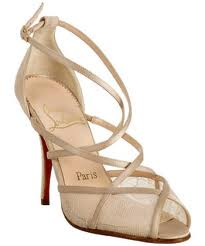Sandals and summer just go together. With so many styles to choose from – flats, gladiators, espadrilles, and high heels, sandals look cute with a variety of summer fashions, including tees and shorts, lacy tank tops and Capri pants, floaty sundresses, summer suits for the office, or evening wear for summer parties and weddings. Plus, sometimes just the right pair will totally complete an outfit.
Unfortunately, wearing sandals can lead to different foot conditions that can cause you foot pain and discomfort. So as you’re buying sandals, you should not only consider which ones look cute and fashionable on your feet, but also which styles will support your arches and feel comfortable on your feet when standing and walking. By following the tips below that address some of the common foot problems associated with sandals, you won’t have to sacrifice your feet’s health to look good while keeping your tootsies cool this summer.
 Flats and Slides
Flats and Slides
Problem: Flat shoes often don’t provide adequate arch and heel support, causing you to develop arch and heel pain. Eventually, you may develop plantar fasciitis. Since flats can cause your feet to function abnormally when walking, you may develop ankle and lower back pain, too. Flats can also place a strain on your Achilles tendon which can lead to the development of Achilles tendonitis.
Since slides are backless at the heel, you may find yourself walking with your toes grabbing at your shoes to help keep them on. This may lead to the development of hammertoe from excessive toe curling. Also, the constant rubbing of your heel against the shoe can lead to calluses and skin lesions called heel fissures and should be treated to avoid severe infection.
Solution: Don’t wear flat shoes or slides every day all day. Avoid walking for long distances in these types of shoes. Perform calf stretches throughout the day to keep your muscles loose and less susceptible to strain. Don’t select flat shoes with thin, flexible soles that can be twisted excessively, since they’ll provide inadequate cushioning for your feet against hard surfaces and very little foot support.
Flip-Flops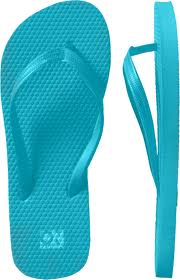
Problem: Often flip-flops are very thin in design providing you with little to no padding between your feet and the ground. Also, they can be very flimsy with little to no arch and heel support. Walking or standing in flip-flops on hard, surfaces for long periods of time can place an abnormal strain on your plantar fascia. Over time this strain can lead to plantar fasciitis. Also, you are more apt to twist your ankle or break your toes when wearing flip-flops since they can slip around on your feet, especially when your feet are wet or sweaty.
Solution: Limit wearing flip-flops to their intended use at the beach, pool, and locker room. However, if you are going to wear flip-flops or flat sandals daily, consider purchasing sandals with built-in arch support. These sandals will help to realign your feet to their natural position, promoting better posture, and relieving the symptoms of plantar fasciitis and excess pronation.
Peep-toe Sandals
Problem: Due to the peep hole, these sandals are not fitted properly they can place a lot of pressure on your toes, since they will want to slip forward and possibly overlap. This action can cause you to develop bunions and hammertoes over time.
Solution: Only wear peep-toe sandals for short periods of time. When buying these sandals, make sure the shoes fit to your arch properly and aren’t too tight; and that there are no seams near the toe area which can cause additional pressure and irritation on your toes.
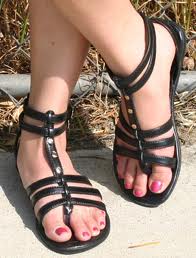 Gladiator and Strappy Sandals
Gladiator and Strappy Sandals
Problem: The straps around the foot or ankle, or between the first two toes, on some gladiator and strappy sandals can irritate your skin due to the constant rubbing motion against your feet during walking. This friction can cause blisters to form. Additionally, the friction of your heels rubbing against the inner sole of the sandals can cause calluses to form as well. Gladiator and strappy sandals also lack proper arch and heel support which can lead to the development of plantar fasciitis.
Solution: Select shoes made from natural materials, such as soft, pliable leather. Ensure that these sandals fit properly to minimize rubbing. Your toes and heels should not hang off of the edges of the shoes since this can cause cuts and scrapes. However, sandals with straps can help to keep your feet in place and limit some injuries like ankle strains better than mules or flip flops.
Ankle-wrap Sandals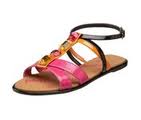
Problem: These types of sandals don’t provide your ankles with adequate support. Therefore, you can twist your ankle easily when walking on uneven surfaces. Like strappy sandals, the ankle strap can rub against your skin causing blisters to form.
Solution: Buy sandals that are made of soft materials, such as leather, cotton, or satin, to reduce rubbing. Make sure you never buckle or tie the ankle strap too tightly to prevent excessive rubbing. If you choose this style it’s wise to buy ankle-wrap sandals with wider straps in order to support the inner and outer ankle area.
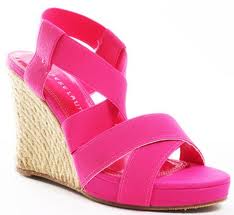 Wedge and Espadrille Sandals
Wedge and Espadrille Sandals
Problem: Wedge sandals with wedges higher than 2 inches tall will increase the pressure on the ball of your foot, leading to metatarsal pain. You also run the risk of your gait being unstable and wobbly – increasing your chances of twisting your ankle. Wedge sandals that fit poorly will cause your feet to slip sideways, leading to blisters and other injuries.
Solution: Choose wedges that are less than 2 inches tall, so you can reduce the pressure on the ball of your foot and help decrease metatarsalgia. Choose shoes with a wider base so your weight is more evenly distributed – providing you with better balance and reducing your risk of trips or falls. Also, rubber soles will provide you with greater traction as well to keep you steadier on your feet. If you choose shoes with an adjustable rear strap, you can tailor your fit to prevent foot slippage in your sandals.
Platform and High Heel Sandals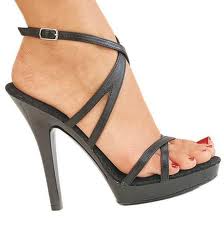
Problem: Platform and high heel sandals more than 2 inches in height place increased pressure on the ball of your foot, which may lead to metatarsalgia. You can also suffer from bunions, corns, calluses, or hammertoe. Additionally, platforms and high heels can cause you to have problems with your balance – increasing your risk of foot and ankle injuries from ankle rolls and/or falls. Platform and high heel usage can also affect your gait due to the unnatural positioning of the foot, resulting in increased stress on your knees, hips, and back.
Frequent high heel use over long periods of time can shorten your Achilles tendon, leading to Achilles tendonitis. Plus, you may experience a loss in the range of motion in your feet.
Solution: Select shoes with heels that are less than 2 inches in height for more stability. Avoid walking on uneven surfaces when wearing this type of shoe.
Customize Your Sandals for the Ultimate Solution
If you’re experiencing foot pain and problems caused from excessive sandal usage, ezWalker® Performance Insoles can provide you with the optimal solution. These insoles are specifically designed to the contour of each one of your feet. That means you will receive customized support so each foot receives proper medial, lateral, and trans-metatarsal arch support. This will relieve pressure on the balls of your feet, and your toes. It will support your foot in a way no shoe alone can. You will walk better since your feet are supported better due to the proper biomechanical repositioning of your feet. Therefore, your feet will feel better at the end of the day.
For open-toe, open-heel sandals, you can secure the ezWalker® Performance Insoles to the foot bed of each shoe with a piece of Velcro® to keep it securely in place. The Velcro allows you to easily remove your ezWalker® Insoles, so you can use them in all of your dress shoes.
Visit The WalkEzStore.com to purchase your pair of ezWalker® Performance Insoles for your sandals today. Stay in step and stay in style with ezWalker® by WalkEz. Because… When your feet feel good you feel good.

